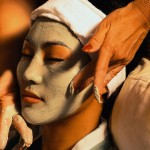Light Therapy for Acne
 Eliminating acne in a non-toxic way requires treating a person from inside and out. While it’s important to understand the mechanisms predisposing a person to acne and treating this predisposition, light therapy can also be a non-toxic adjunct to help. The MayoClinic, in this article http://www.mayoclinic.com/health/acne-treatments/SN00038, goes through the various light and laser treatments that are in active use as of April 2010. Being a naturopathic physician, I don’t agree with the chemicals described in this article but light therapy is worth mentioning here. In this article, the MayoClinic describes the following therapies. I’ve added additional information about blue-red light therapy.
Eliminating acne in a non-toxic way requires treating a person from inside and out. While it’s important to understand the mechanisms predisposing a person to acne and treating this predisposition, light therapy can also be a non-toxic adjunct to help. The MayoClinic, in this article http://www.mayoclinic.com/health/acne-treatments/SN00038, goes through the various light and laser treatments that are in active use as of April 2010. Being a naturopathic physician, I don’t agree with the chemicals described in this article but light therapy is worth mentioning here. In this article, the MayoClinic describes the following therapies. I’ve added additional information about blue-red light therapy.
Blue-Red light therapy: Blue light destroys Propionibacterium acnes (the bacteria that causes the inflammation and infection that produces acne). Red light reduces inflammation and improves healing of the skin. Because the bacteria rapidly multiplies, treatment needs to be twice daily for 15-30 minutes each session. Side effects are minimal and include temporary redness, dryness and maybe flaking. The British Journal of Dermatology in its May 2000, Volume 142, Issue 5 article states that after 12 weeks of treatment 76% improvement in inflammation and 58% improvement in acne was achieved. While these results are significant, Acne.org (http://www.acne.org/light-acne.html) states that non-inflamed black-heads and white-heads respond best; whereas inflamed cysts and nodules respond more poorly. Cysts and nodules are walled off from the outside so it’s even more important to work internally to reduce the predisposition to form these. The blue-red spectrum doesn’t include UV rays, so it’s not cancer-causing. However, blue light can be harmful to the retina of the eye, so saftey goggles are needed. You can get this type of therapy at dermatologists’ or aestheticians’ offices or you can purchase the lamps themselves for self-treatment. Home devices range from expensive to inexpensive units to just the plain light bulbs themselves. Doing an Amazon.com search for blue and red light therapy for acne will provide you with some of the many options. LED sources appear to have deeper action, are convenient, and require shorter treatment times (British Journal of Dermatology’s article called Guidelines for Topical Photodynamic Therapy, Volume 159, Issue 6). The plain light bulbs can be screwed into a lamp by the bed where one can spend an extra 15 minutes basking in the light before getting up or going to sleep.
Pulsed light and heat energy therapy: This is a combination therapy that kills the bacteria that causes the inflammation and infection that produces acne and shrinks sebaceous glands resulting in lower oil production which the bacteria feeds off. Side effects are again minimal and include temporary redness.
Diode laser therapy: Diode lasers destroy sebaceous glands in the middle layer of skin, which makes me a little more wary of this treatment. And it can be painful with requires pain medication to be applied with treatment. Side effects are again minimal which includes temporary redness and swelling of the treated areas.
Photodynamic therapy: Because I am a naturopathic physician, I don’t promote this therapy because of the use of strong topical chemicals. For educational purposes, this treatment combines topical medication with blue-red or pulsed light therapy.
Photopneumatic therapy: Using a vacuum suction to remove the oil and dead skin cells from within the sebaceous glands, this therapy combines blue-red light therapy with treatment.
To end with, the June 2009 (Volume 160, Issue 6) publication of the British Journal of Dermatology compared 13 different light therapies and found them to be inadequate, except for blue light, blue-red light and infrared radiation. They even stated that blue-red light was more effective than topical 5% benzoyl peroxide cream, a common chemical used in anti-acne medication.
 Blog, Health Tips
Blog, Health Tips April 1st, 2012
April 1st, 2012
Links to Blog
- Sun Safety, Sunscreen Safety and Vitamin D
- American Ideals Meets Children The Challenge and Mrs. Piggle Wiggle
- How To Avoid Getting Covid-19
- Homeopathy In Epidemics
- Arsenic in Rice
- Abraham Lincoln- a Homeopathic Enthusiast
- Chocolopolis: The Best Chocolate Shop in Seattle
- Beneficial Organisms in Unforeseen Places
- Simple Measures for Insomnia
- Obesity- An Inflammation and Hormonal Problem
- Cold Water Dips for Vitality
- Canker Sores
- Light Therapy for Acne
- Reputable Supplement Brands
- Finding One’s Passion in Life
- How to Make a Salve
- Fasting for Better Health
- The Dirty Dozen (of Foods)
- Foods to Avoid, Experts Say
- Book Review: Incognito by David Eaglemann
- Fiber-full and delicious: Spanish lentil recipe
- Colds and Flus
- Musculoskeletal Injuries 101
- Professional Athletes Practicing What They Eat
- A Single Homeopathic Medicine Converts a Skeptical Doctor
